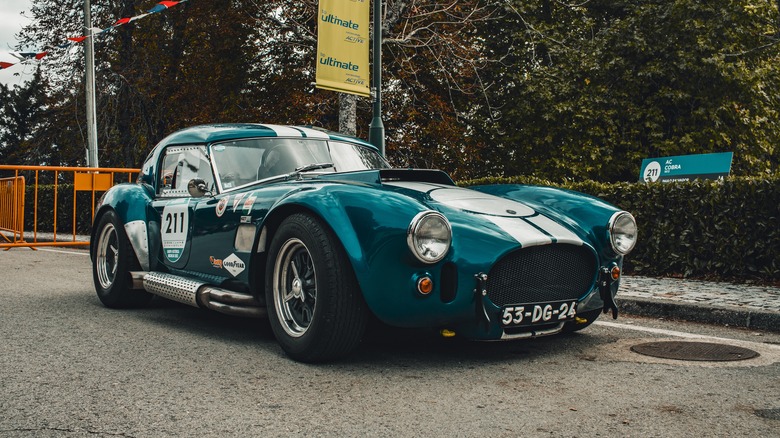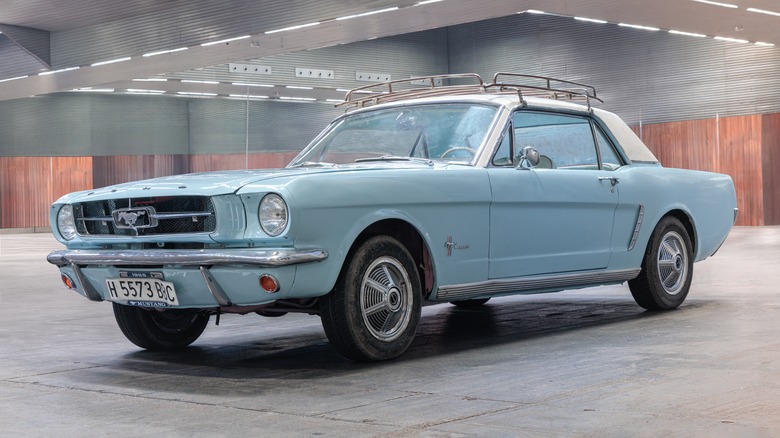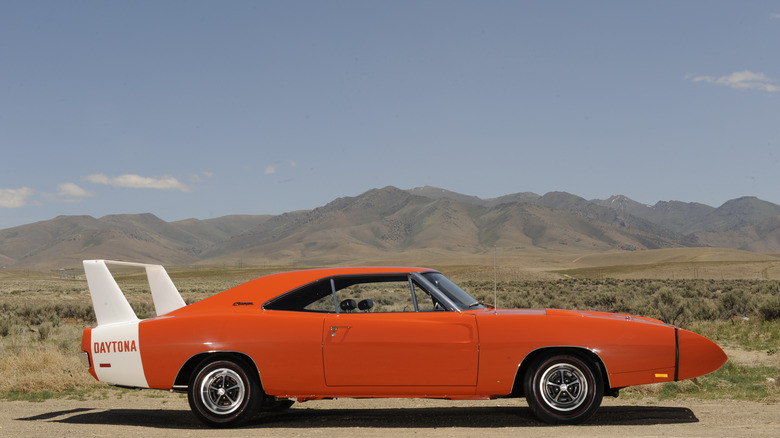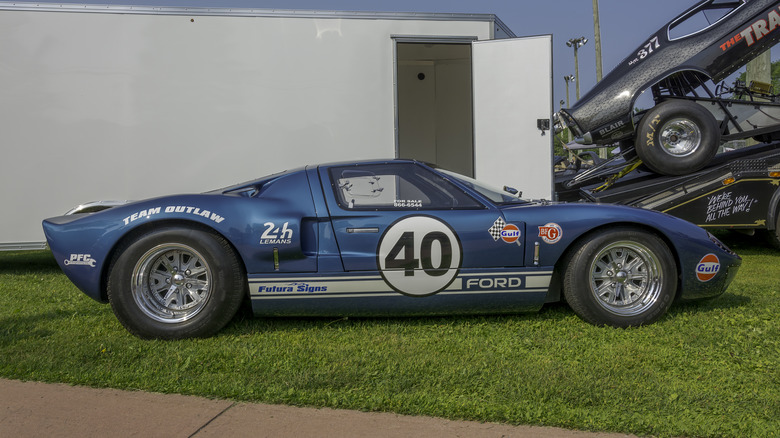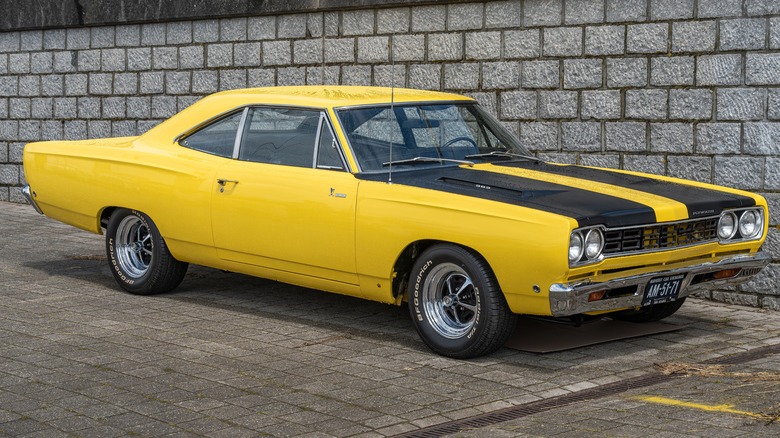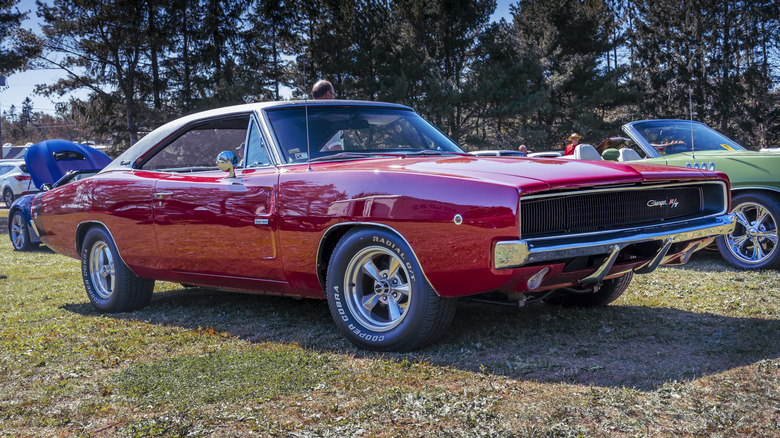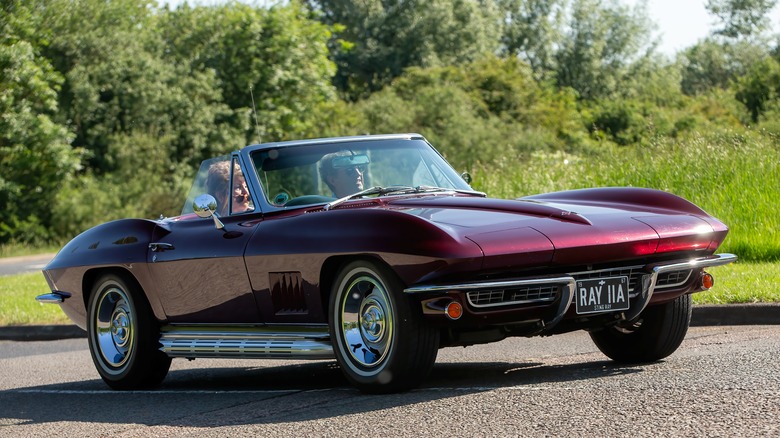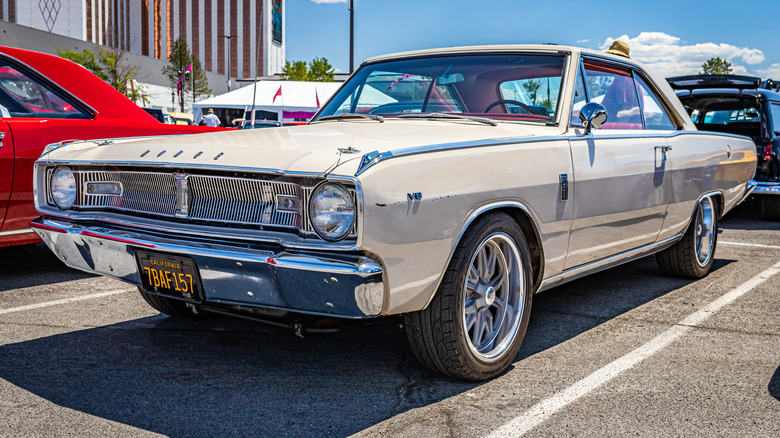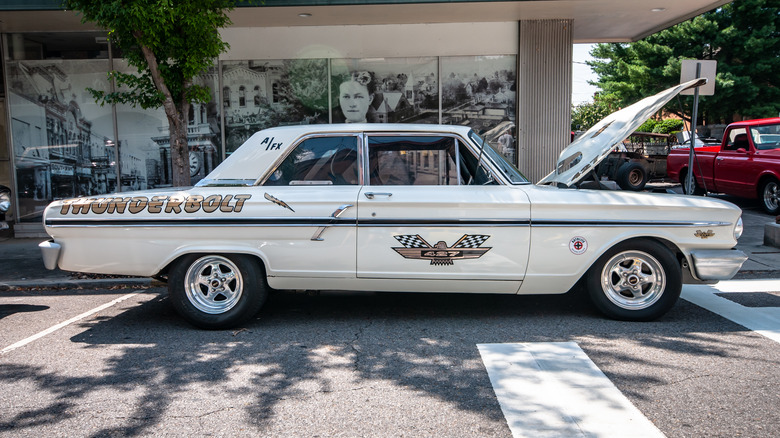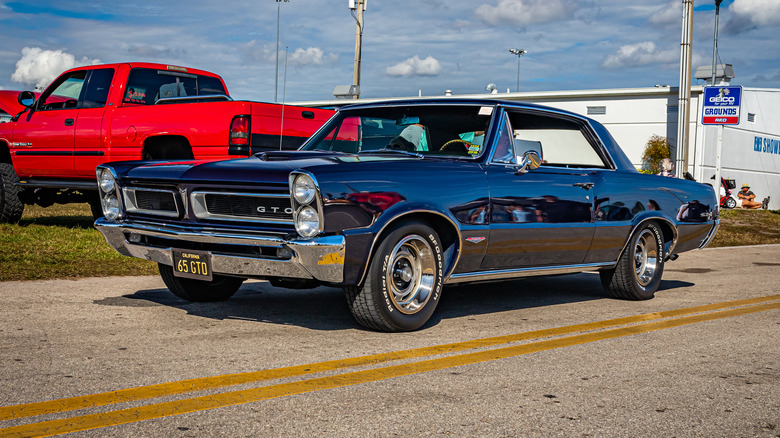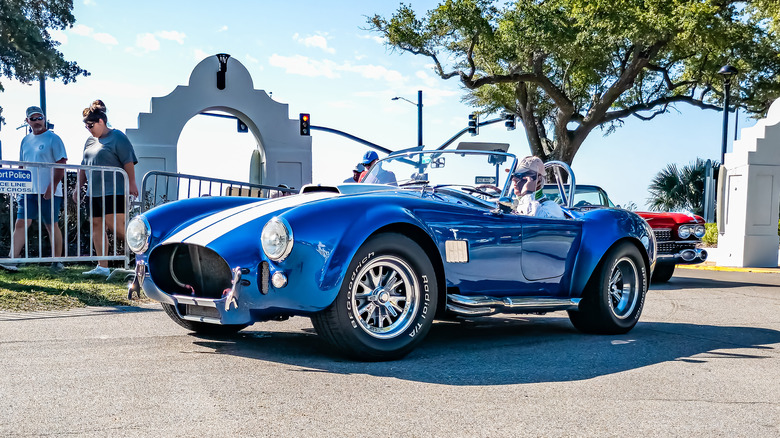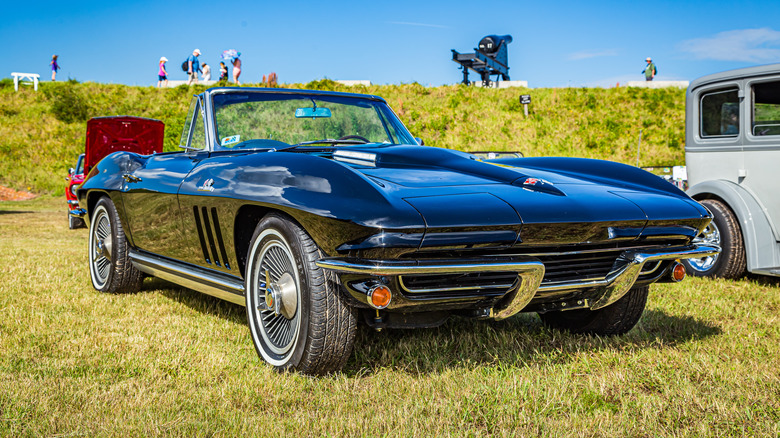10 Of The Fastest Classic Muscle Cars Of The 1960s, Ranked By Speed
The 1960s was a time of great change in the U.S. The country was right in the thick of the civil rights movement, the emergence of hippies, the birth of rock music, and the era of the American muscle car. Automakers had found that people liked driving huge V8 cars that could go really fast and started a veritable arms race to see who could make the fastest cars with the biggest engines. By the end of the decade, engines were easily clearing 400 horsepower.
The big players of that era included Dodge, Ford, Chevy, and GM's other automakers like Cadillac. Each manufacturer was putting out a new engine every few years as they figured out ways to encourage more and more power out of increasingly larger engines. This led to some of the greatest big block V8 engines of all time, like the Ford 429 Super Cobra Jet, Chrysler 426 Hemi, and the Chevrolet ZL1 427. These monster engines put out hundreds of horsepower and added some giddyap to the cars they powered.
With such an emphasis on speed, it's entertaining to imagine who did it the best. After all, engines can only get you so far. The car has to be made the right way in order to get the fastest possible times. That includes weight, transmission tuning, and aerodynamics. So, while many cars in the 1960s had massive engines, they were not all equally fast. Below are the fastest cars that we could find from the entire decade.
1965 Ford Mustang GT 289
The 1965 Ford Mustang GT starts our list with a bang. It was an important year for the Ford Mustang because it was just the second year that the Mustang was available to the public, and Ford had already made quite the splash with the now-iconic muscle car. It was built specifically for what was going on in the 1960s and was under development as early as 1961. The car was an instant success, selling 418,000 units its first year and setting a record at the time for most cars sold in a new car's first year.
In terms of speed, the car can clear zero to 60 MPH in 5.2 seconds with a quarter mile run accomplished in 14 seconds flat while reaching a top speed of 100 MPH. It accomplished this feat with a 289 cubic inch V8 that could pull as much as 306 horsepower depending on the configuration. It also weighed less than muscle cars would eventually weigh later on in the 1960s with a rated curb weight of a little over 2,800 pounds. That, combined with the hot 289, gave the Mustang some speedy chops.
The 1965 Ford Mustang GT 289 isn't the rarest car in Ford's lineup as the company reportedly sold over 500,000 of them. Coincidentally, the first Shelby Mustang was also manufactured in 1965. Somewhat ironically, the performance-oriented Shelby Mustang was slightly slower getting to 60 MPH than the regular Mustang GT at 5.4 seconds but was slightly faster in the quarter mile dash at 13.9 seconds.
1969 Dodge Charger Daytona 426 Hemi
The 1969 Dodge Charger Daytona was a car built to win. By this time in the decade, the big automakers were slugging it out as hard as they ever had before for dominance, particularly in the NASCAR circuit. The Dodge Daytona was part of this push and its unique design for its day is part of that. As per NASCAR's rules at the time, Dodge made a little over 500 of these for production, but it was first and foremost built as a race car.
It was quite good at what it did. The Daytona was able to scoot from zero to 60 MPH in 5.2 seconds with a quarter mile drag time of 13.7 seconds, making it overall slightly faster than either 1965 Ford Mustangs we talked about earlier. It accomplished this feat through a mixture of its aerodynamic design paired with its absolutely massive 7.0-liter engine that produced 430 horsepower and 490 lb-ft of torque. It also featured a dual carburetor design. This car could've gone faster but its downfall was its 4,079-pound curb weight, which is as much or more as some modern crossover SUVs weigh.
Dodge did pretty well with this car. It won two NASCAR races in 1969 and another four in 1970. It also had some other notable historic achievements. It was the first NASCAR vehicle to eclipse 200 MPH on the track. Its high speeds allowed it to win the Talladega 500, which is one of NASCAR's longest oval tracks and, as a result, where drivers often get see the highest speeds.
1967 Ford GT40 Mark III
The Ford GT40 Mark III is part of a prestigious lineup of cars. The original GT40 was the car designed by Ford to beat Ferrari at Le Mans. You may have seen it if you've ever watched the movie "Ford v Ferrari." Ford didn't stop there and made more GT40s, winning at Le Mans every year from 1966 to 1969. So, not only is this car fast, but it can also be pushed hard for a long time.
The GT40 Mark III was able to go from zero to 60 MPH in 5.1 seconds with a quarter mile drag time of 13.8 seconds. It ran Ford's 289 cubic inch V8 that was capable of producing 306 horsepower and 329 lb.-ft of torque. That seems low compared to some other cars on here, but this car was designed for going fast and didn't need as big of an engine to do it. Plus, the car was much lighter than many muscle cars of the 1960s, weighing in at a scant 2,299 pounds. It also shared many components with prior generations, all of which won at Le Mans as well.
These were part of the glory days for Ford and the impact of the GT40 series of cars on American automotive history are set in stone. There are few cars with the GT40's pedigree and although it wasn't the fastest thing on four wheels, it was fast enough and reliable enough to beat Ferrari four consecutive times.
1969 Plymouth Road Runner 426 Hemi
The Plymouth Road Runner 426 Hemi is quite the name for quite a car. Design wise, this speed demon isn't too different from other Road Runner cars that Plymouth made in the late 1960s, but the automaker managed to score big with this one in terms of performance. People seemed to enjoy the car in 1968, so Plymouth doubled down in 1969 and included additional options, such as a convertible model. It also had an iconic beep-beep horn sound, mimicking the Road Runner from the Looney Tunes cartoon show.
The name was well deserved as the Road Runer 426 could get to 60 MPH in 5.1 seconds with a quarter mile run of 13.5 seconds. Powering the Road Runner was a 426 cubic inch Hemi V8 that could produce 425 horsepower and 490 lb-ft of torque. The engine was an optional upgrade, so not every 1969 Road Runner has it. The base engine was no slouch either, pushing the Road Runner to 60 MPH in 7.1 seconds with a 14.3-second quarter mile time. It was also lighter than a lot of muscle cars of the era at 3,436 pounds.
Plymouth only produced the Road Runner for a handful of years in the late 1960s and early 1970s. While it started off as a hit with customers because of its tie-in with the Road Runner cartoon, it eventually won MotorTrend's Car of the Year award in 1969, helping to cement its legacy.
1968-69 Dodge Charger 426 Hemi
The 1968 Dodge Charger 426 Hemi is a monster. Not only is it one of the most iconic American muscle cars ever produced, but it had the performance to match. It has that American muscle car look that you've likely seen in any movie or TV show from that era and its multiple engine options made it a popular choice among shoppers. It might be more well-known for its base engine since that's what most people bought, but the few who opted for the 426 Hemi were in for a real treat.
The 426 cubic inch V8 Hemi was a real showstopper in the Dodge Charger. The car sprinted to 60 MPH in 4.8 seconds with a quarter mile run of 13.5 seconds. Those numbers are doubly impressive considering that the Dodge Charger weighed almost 4,000 pounds, which is quite heavy. Dodge's 426 V8 Hemi made 425 horsepower and 490 lb.-ft of torque, so the car had plenty of power to get where it needed to go. The 1969 Dodge Charger also had similar specs, which means it was able to go at similar speeds.
Here's the thing, the other V8 engines on the Dodge Charger from those years was pretty powerful as well. Virtually anyone who bought one was having a good time. However, because it was rather expensive, only a few hundred people opted for the 426 Hemi, so this is also a fairly rare configuration for this otherwise iconic car.
1967 Chevy Corvette 427
Chevy Corvettes are known for being pretty quick regardless of the decade, but the '60s had some fast ones, and none were faster than the 1967 Chevy Corvette 427. It also looked different from other muscle cars with its smaller, angular body that made it stand out in a sea of larger, heavier muscle cars. Plus, its retractable headlights were iconic in their day, making the car look that much more aggressive. Like most muscle cars, the 'Vette had multiple engine options, but the 427 was the largest.
With its biggest engine, the 1967 Corvette could fly. It registered a zero to 60 MPH time of 4.7 seconds and tackled the quarter mile in 13.4 seconds. Part of that was the 427 cubic inch big block V8 that Chevy managed to stuff into it. The engine made 435 horsepower and 460 lb-ft of torque. That was more than enough power to push the Corvette's 3,175-pound frame. The '67 Corvette also came with a triple 2-barrel carburetor along with an advanced suspension setup that allowed the car to carry a heavier engine despite its smaller frame.
As such, the Corvette was able to hold its own in competitions, even against European competition. It was also insanely popular, having over a decade to cement its legacy. This was also the final year for the second-generation Corvette before the third generation took the reins in 1968. That car was still quick, scooting to 60 MPH in 6.3 seconds.
1968 Dodge Dart GTS
The 1968 Dodge Dart GTS is a unique vehicle. It has the larger body styling of American muscle cars of the era, but it managed to be one of the fastest things on four wheels during that era. In addition, it played second fiddle to the legendary 1968 Dodge Charger lineup, despite actually being faster depending on the configuration. To get the fastest Dart, you needed to get the upgraded GTS model and then you had to snag one of the exceedingly rare Super Stock models with the 426 Hemi in it.
If you managed that, you had a sleeper if there ever was one. The 1968 Dodge Dart GTS with the 426 Hemi went from zero to 60 MPH in 4.7 seconds with a quarter mile time of 13.1 seconds, beating out even the Chevy Corvette. Of course, Dodge's absurdly powerful 426 Hemi played the biggest role with its identical specs to the Dodge Charger of the same year. The biggest difference is that the Dodge Dart weighed significantly less than the Dodge Charger Daytona from 1968, which definitely helped the car move faster.
Like many other cars on this list, the 426 Hemi variant of the Dodge Dart GTS is quite rare. Reportedly, only about 80 were ever made. So, if this is the first time you've ever seen this particular configuration, that's why. Nevertheless, this little car could burn rubber and fling gravel with the best of them and is among the fastest cars of the 1960s.
1964 Ford Fairline Thunderbolt
The 1964 Ford Fairlane Thunderbolt is another rare car that was built for speed and little else. Ford built exactly 100 of these cars with about half of them being automatics and half of them being manuals. The reason why Ford built so few is because this wasn't meant as a production car. It had myriad modifications directly from Ford so that it could win drag races, which it did very well.
The Ford Fairlane Thunderbolt was capable of doing zero to 60 MPH in as little as 4.4 seconds and did a quarter mile run in 13.1 seconds. Under the hood was Ford's potent 427-inch V8 that made 425 horsepower and 480 lb-ft of torque. That was competitive enough for its era, but Ford did some other stuff to this car before it left the factory. That includes lowering the weight significantly as the car only weighed 3,225 pounds. To do this, Ford omitted a number of comfort-oriented items from the car, including sound deadening, a backseat, a heater, and even the radio.
Ford's attention to detail paid off as the Thunderbolt was one of the most successful cars in racing in the early 1960s. With Ford's full configurations in place and a few other modifications, the Thunderbolt could clear a quarter mile in 11 seconds, which was fast enough to take home the NHRA Top Stock trophy and the NHRA Manufacturers' Cup in 1964.
1964 Pontiac Tempest GTO
The 1964 Pontiac Tempest GTO is surprisingly quick, and it helped set the tempo for the rest of the decade. While the first American muscle car is a hotly debated topic, the Pontiac Tempest GTO is in the conversation for some folks. It features the muscle car style that wasn't terribly popular at first but grew on consumers over time. For anyone who's curious, the GTO stands for Gran Turismo Omologato, which translates to Grand Touring Homologated.
Not every Pontiac Tempest was quick, but the GTO was. The car's 389 cubic inch engine propelled the GTO to 60 MPH in 4.6 seconds and blasted through a quarter mile in 13.1 seconds. By contrast, the 1964 Ferrari 500 Superfast boasted a 4.9-second zero to 60 time and a 13.4-second quarter mile, which means that the GTO was one of the first American automobiles to beat Ferrari at something. It accomplished this feat with an engine that could do 348 horsepower and 428 lb-ft of torque. It weighted 3,485 pounds.
The car was so powerful that some reviewers from the era found it hard to test. Pontiac did such a good job tuning the engine and adding things like the triple two-barrel carburetor that wheelspin made it difficult to get accurate measurements in terms of speed times. Even with egregious wheel spin, the car could zero to 60 MPH in under six seconds. It was a real monster and every test proved it.
1965 Shelby Cobra 427
Say hello to the fastest American muscle car of the 1960s. It's fair to say that basically every year of the Shelby Cobra was pretty quick and most of the years would land somewhere on this list. However, for the sake of giving other automakers some space, we'll let the Shelby Cobra adorn our list just once and we'll use the fastest model that we could find, which was from 1965.
At its best, the 1965 Shelby Cobra 427 raced to 60 MPH in 4.3 seconds with a quarter mile time of 12.2 seconds. Its hustle is largely due to Ford's excellent 427 cubic inch V8 that put up an astounding 485 horsepower and 480 lb.-ft of torque. The other big helper was the fact that the car weighed 2,529 pounds, which is over 1,000 pounds less than many other American muscle cars. The next fastest iteration of the Shelby Cobra was the 1964 Shelby Cobra Daytona, which registered 4.4 seconds going from zero to 60 MPH and 12.7 seconds in a quarter mile run.
Real Shelby Cobras are rare, and the most famous ones often auction for millions of dollars. These days, many people opt to use kits made by third parties to make their own Shelby Cobra for much less money than an original. Even those kit cars are still pretty fast. Shelby still makes the Cobra to this day and it remains one of the fastest cars you can buy.
How we sorted these cars
There are several different ways to categorize how fast cars are. Some examples include top speed, zero to 60 MPH times, zero to 100 MPH times, quarter mile runs, and track lap times — assuming you have access to a track. Each metric has its own set of pros and cons. For example, top speeds are often locked via a governor and cars can take a long time to reach those speeds. Generally, all of these metrics help add additional layers to how fast cars are, but for the sake of simplicity, we used two.
First, we'll used zero to 60 MPH times to order the cars from fastest to slowest in the context of the list. In the event of a tie, we used quarter mile sprint times as tiebreakers. Most of these vehicles were street cars and were designed for such use cases. Since 60 MPH is highway speeds, seeing how fast a consumer-oriented car can get to highway speeds is a good starting point. Since most drag strips are a quarter mile, we didn't want to invalidate those numbers either, so we used it as a backup in the case of a tiebreaker.
Finally, all the data used is for cars operating on stock hardware so that they are judged as the automaker intended. Modifications are inconsistent from vehicle to vehicle and while you can easily squeak more power out of all the vehicles below, modifications add too many variables to judge accurately.
